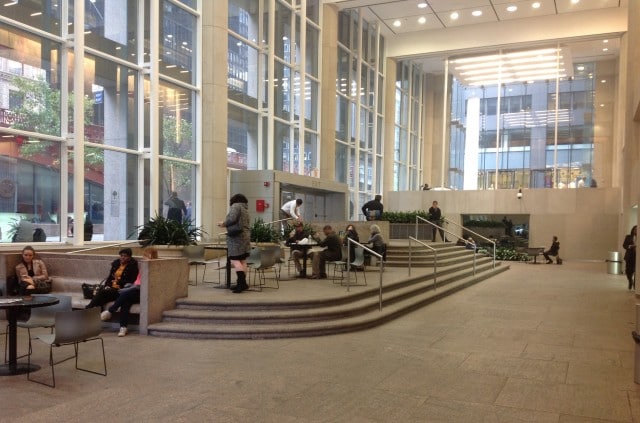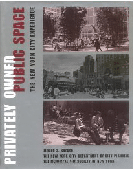
120 Park Avenue
Burnishing its image as a leading arts patron, the Philip Morris Company has devoted much of its glass- and granite-enclosed multistory covered pedestrian space to a successful collaboration with the Whitney Museum of American Art. Located at the southwest corner of Park Avenue and East 42nd Street across from Grand Central Terminal and open seven days a week, the space has displayed sculptures from that museum’s permanent collection since it was completed in 1982. With the Whitney able to exhibit only a small percentage of its collection at any one time, arrangements such as this can benefit space-hungry museums, corporate patrons, and members of the public alike. Indeed, such collaborative efforts are models for cultural institutions seeking new locations and audiences for their exhibits, concert series, dramatic presentations, and similar artistic endeavors, and for privately owned public space owners wondering how they may revitalize their spaces.

The covered pedestrian space may be entered either from East 42nd Street or Park Avenue under an arcade wrapping around north and east sides of the building. Unlike some designs, this one unapologetically separates the private lobby entrance from the public space entrance, locating the private entrance at the northwest corner of Park Avenue and East 41st Street. The closest that public space users come to that lobby is via a view through windows on the western and southern walls of the space. Despite this separation, there is no evidence whatsoever that the space has been disowned by its host building.
The Park Avenue entrance offers the most dramatic entrance, placing the user on a terrace seven steps above the floor and providing a vantage point from which to survey the space, the artworks, and the functional amenities. With its substantial height, narrow width, and gray granite columns, the space could have conveyed an austere formality were it not for its use of generously sized windows on all four walls that cleverly expand the visual boundaries and allow in large amounts of natural daylight. In combination with recessed ceiling lights, the windows guarantee a light and airy atmosphere unusual for most indoor privately owned public spaces. The artwork also humanizes the space. Over the years, sculptures have been scattered about, in close proximity with users, spawning an informal immediacy delightfully at variance with the customary formal museum setting. Long-time visitors may recall George Segal’s buoyant bronze with white patina, called Dancers, of four nude women dancing together, holding hands, in homage to Matisse’s Dance. Also installed was a painted chrome-and-metal work, entitled City Lux, by John Chamberlain, composed of crushed automobile parts. Other standouts from the past have included Jonathan Borofsky’s Man with a Briefcase, Deborah Butterfield’s horse sculptures, and Roy Lichtenstein’s Three Brushstrokes. A Frank Stella abstract painted metal relief endures on the western wall.
The Whitney also operates a free special exhibition area to the west of the entrance at East 42nd Street, with exhibits refreshed six times a year and gallery talks on Mondays, Wednesdays, and Fridays. The sign that once banned food and beverages in this exhibit space now bans smoking as well, a sign of the times even at the Philip Morris Building. Other public spaces that endeavor to provide a critical mass of art include the covered plaza at Two Lincoln Square and the covered pedestrian space at 590 Madison Avenue. An effort at tying a Whitney branch to another public space foundered years ago, at Two Federal Reserve Plaza downtown.
Even without the art, the space satisfies many preferences of public space users. A food kiosk at the southwest corner provides refreshment. Next door are the public restrooms, not identified as such and requiring a security guard pass to enter. Two nearby pianos are available for ongoing programs. Numerous movable black tables and chairs cover the floor next to the kiosk and pianos, supplemented by comfortable built-in benches to the east that are continuously occupied. Closer to East 42nd Street and Park Avenue is a platform three steps up that is covered with movable tables and chairs nestled among several trees. Still more built-in benches here and at the northeast corner offer nooks and crannies for users.
One additional fact about the Philip Morris building is worth noting. When the City designated Grand Central Terminal a landmark in 1967, it also authorized the terminal owner to transfer otherwise unusable development rights to adjacent parcels. The Philip Morris building was the first building to take advantage of this option, purchasing 74,655 square feet of development rights from the terminal owners for use here. Recently, 383 Madison Avenue became the second building to utilize some of Grand Central Terminal’s development rights.



Hello,
I work in the 120 Park Building for Bloomberg LP as an event planner. We are trying to create a pop up store feel for a multi day event in midtown NYC and thought the public space in the lobby of our building would be a perfect location and feel. Is this space reservable? Are there limitations to it?
Please reach out to me via email or phone at mfiddle@bloomberg.net or 646-324-2001 and let me know what can be done, if anything, with the space.
Thank you very much,
Michael
Many required amenities are missing or not in conformance: Required signage on entry doors not in conformance with approved plans , Retail Frontage missing, Food Service in Covered Pedestrian Space: adjacent to space missing, Other Amenity special exhibition area adjacent to Covered Pedestrian Space used by Whitney Museum of American Art with changing exhibits about six times a year is missing, required bathrooms frequently closed
Please see comments submitted today on missing amenities
Thanks for the information. This POPS used to be one of the best indoor spaces in the city. The George Segal sculptures still resonate. But in recent years it has lost its luster. Yes, where is the Whitney branch, missing for years and years? Perhaps the changes across the street on Vanderbilt Avenue and the impending East Midtown rezoning will create momentum to upgrade this underperforming POPS. After allow, millions of dollars later, the David Rubenstein Atrium at the Lincoln Center campus went from also-ran to one of the best.
Currently marked as ‘closed until further notice’ (apologies for image quality)
Dear Matthew, Under a city Executive Order, indoor POPS have been able to close as long as they give notice to the City. We understand that the Executive Order with regard to indoor POPS will be changing in the near future. APOPS|MAS